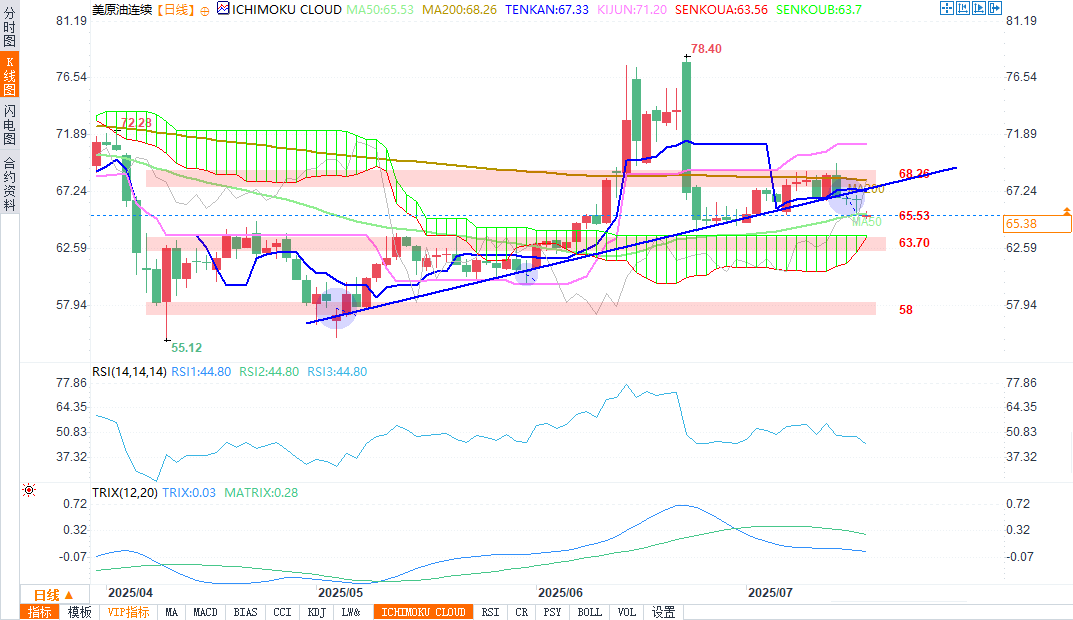Crude oil analysis: WTI crude oil holds the $65 mark and has not yet stabilized effectively
2025-07-17 18:56:32

In the past three trading days, WTI crude oil prices fell by more than 4%, falling below the $65 level, further consolidating short-term bearish sentiment. As investors digest the latest report from OPEC+ and the uncertainty caused by the re-escalation of the trade war, crude oil selling pressure remains high. If these factors continue to ferment, oil prices may face more persistent downward pressure in the short term.
Meanwhile, Chinese data showed second-quarter economic growth data was more optimistic than the market expected, partly due to the early release of pressure from U.S. tariffs. In addition, China's crude oil throughput in June increased by 8.5% year-on-year, indicating stronger crude oil demand.
The weekly crude oil inventory change data released by the U.S. Energy Information Administration (EIA) yesterday showed that U.S. crude oil inventories fell sharply by 3.9 million barrels, indicating increased refinery activity and tight supply. This decline was larger than expected, reflecting the growth of domestic demand in the United States. However, rising gasoline and diesel inventories limited the rise in oil prices, indicating that demand for refined oil may face resistance.
What is OPEC+’s stance?
OPEC+ pointed out in its latest report that the global economy may perform better than expected in the second half of 2025, and the economic growth rates of countries such as India, China and Brazil will exceed previous forecasts. Although this outlook suggests that crude oil demand is expected to strengthen, the organization also confirmed the decision to gradually increase production - according to the announcement on July 5, an additional 548,000 barrels per day will be added from August.
The latest data has reflected this trend of increasing production. In June, OPEC+ crude oil production reached 41.56 million barrels per day, an increase of 349,000 barrels from May. Most member countries have increased their production, with Saudi Arabia performing outstandingly, increasing its production from 9.05 million barrels per day to 9.3 million barrels per day. This confirms OPEC's intention to transition to a high-output environment, and this trend is likely to intensify in the coming months.
The current crude oil production pattern has changed. Not only the United States is increasing production, but OPEC has also joined in, which has caused market concerns about the imbalance between supply and demand. If demand growth is lower than expected, the market may face an oversupply situation, leading to a backlog of crude oil inventories. In the coming weeks, a sharp increase in crude oil inventories may further increase the selling pressure on WTI crude oil.
Does the tariff issue affect the crude oil market?
Recent statements by the White House have raised concerns about a global economic slowdown - if no concrete agreement is reached, dozens of countries could be affected. In the latest developments in the trade war, the United States has imposed new tariffs of 30% on the European Union, Mexico and other regions. At the same time, the European Union is preparing countermeasures against the United States, which could cause greater economic uncertainty if tensions continue to escalate.
From the perspective of market confidence, some sentiment indicators have shown signs of fatigue, especially concerns that escalating trade conflicts may affect crude oil demand in the coming months.
As pessimism continues to grow across crude oil market indicators, it is clear that the latest phase of the trade war has begun to affect crude oil price expectations. If this uncertainty continues, WTI crude oil may face stronger downward pressure in the short term.
However, there is also a view that oil prices may rise as US President Trump lifts the ban on the sale of artificial intelligence chips to China and announces a trade agreement with Indonesia. Reuters quoted John Paisie, president of Stratas Advisors, as saying that Trump is also optimistic about potential trade agreements with India and Europe.
Technical Analysis

Trendline Break: Since the beginning of May 2025, despite recent volatility, WTI crude oil has tried to maintain a stable upward trend. However, in the latest trading day, selling pressure increased significantly, breaking the previous sustained upward trend line. If the selling pressure continues, it may trigger a new bearish pattern in the short-term price trend.
Relative Strength Index (RSI): The RSI indicator has started to turn downward and is currently fluctuating below the neutral 50 level. This shows that bearish momentum is gaining momentum and if this trend continues, it could signal a rise in selling dominance in the short term.
Triple Exponential Smoothing (TRIX): The TRIX indicator is also showing a similar trend and is currently moving down. This change means that the average strength of the moving averages is entering bearish territory and if the negative slope persists, it may signal a shift in momentum towards sellers.
Key price:
$68 – Major Resistance: This level coincides with the 200-period simple moving average. If bulls push the price to reach this area again, it may reactivate the underlying bullish bias from the previous trading session.
$65 – Near-term support: This level coincides with the 50-period simple moving average. A sustained move below this level could confirm the formation of a clear bearish bias.
$63 – Key Support: This area was the neutral range during April-May and has now become the most important support level. A break below this level could signal the start of a more sustained bearish trend.
At 18:39 Beijing time, WTI crude oil was quoted at US$65.44 per barrel, up 0.38%.
- Risk Warning and Disclaimer
- The market involves risk, and trading may not be suitable for all investors. This article is for reference only and does not constitute personal investment advice, nor does it take into account certain users’ specific investment objectives, financial situation, or other needs. Any investment decisions made based on this information are at your own risk.










